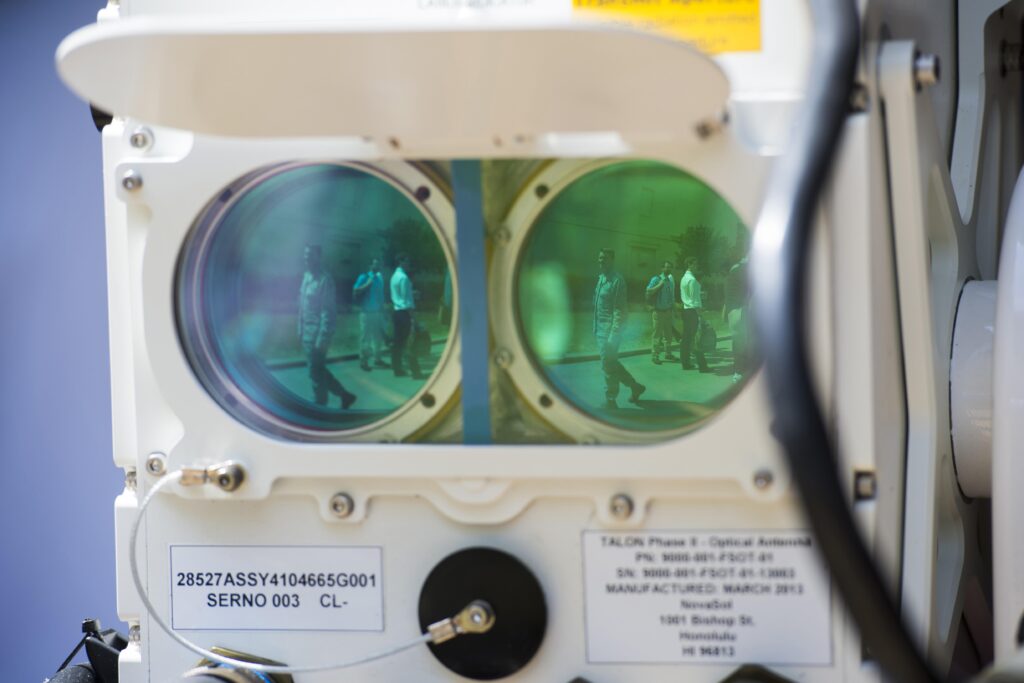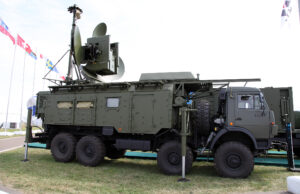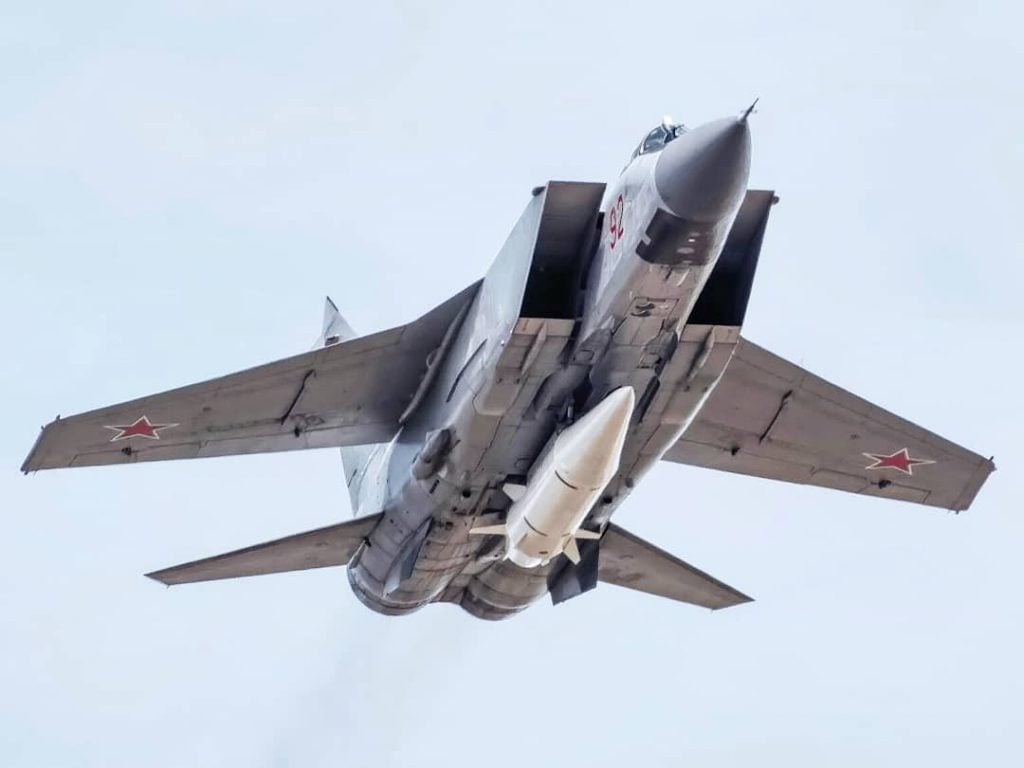By SYDNEY J. FREEDBERG JR
 Pentagon R&D chief Mike Griffin wants to revive the idea of space-based lasers for missile defense, a concept he worked on during the Reagan “Star Wars” program, as illustrated here.
Pentagon R&D chief Mike Griffin wants to revive the idea of space-based lasers for missile defense, a concept he worked on during the Reagan “Star Wars” program, as illustrated here.
WASHINGTON: Laser beam communications no enemy can jam. Microwave emitters to fry enemy satellites or incoming hypersonic missiles. AI-controlled lasers shooting down hostile drones faster than a human can react. The Pentagon’s chief of R&D, Mike Griffin, sees tremendous potential for directed energy — both by itself and in combination with his other high-tech priorities like artificial intelligence, hypersonic weapons, secure communications, and space warfare.
“More than any other of the areas in my portfolio,” undersecretary Griffin said, “I think the leverage of directed energy is so high … that it is right at the top of my investment priorities.”
“My principal goal for directed energy actually is to have it stop being ‘the technology of the future and already will be’ and move it into the fleet, move it into the field,” Griffin told the CSBA-BAH Directed Energy Summit here this morning. ” “We hope, by the end of another year or so, to have some of these things operational at the tens or low hundreds of kilowatts level on real DoD platforms. Put them into the field, try them out, see what they can do for us.”
Griffin started working on laser weapons over 30 years ago as part of Reagan’s Strategic Defense Initiative, dubbed “Star Wars” for its emphasis on orbiting anti-missile lasers that proved beyond the technology of the time. He still likes giant space lasers, but he’s also increasingly excited by smaller systems that are closer to earth..
Spike in 2020 due to congressional plus-up; Congress has not yet acted on 2020 request. SOURCE: CSBA analysis of DoD budget data.
“I really do want… megawatt lasers in space for space control,” Griffin said — no doubt to the dismay of any arms controllers in the audience — “but I also believe in the value of 75 kilowatts on top of the Stryker, or 100 kilowatts on the Littoral Combat Ship, or a couple of hundred kilowatts on a KC-46 next-generation tanker so that it can self-defend.”
That said, Griffin cautioned, directed energy isn’t as mature — or as widely applicable — as artificial intelligence, so it’s not ready for a DE equivalent of the recently created Joint AI Center. “They’re not a research center, they’re an applications center,” he said of JAIC, which seeks to quickly field cutting-edge AI tech for military uses ranging from tracking terrorists to helicopter maintenance.
“I don’t think directed energy is far enough along, yet that we should be thinking about some similar joint directed energy center,” Griffin said, stressing that yet. “There’s too many different technologies that need to be developed a little bit more fully, at least to the prototype weapons stage, before you can start thinking about how you’re going to fight with them.”
TALON laser communications device.
Lasers: Kill & Communicate
Lasers are particularly attractive for air and missile defense for three main reasons: They offer essentially unlimited shots, as long as electrical power holds out; each shot costs only the price of electricity; and the beams move to their target at the speed of light, which makes even hypersonic missiles look slow.
But to take full advantage of lasers’ capability to engage lots of targets very fast, Griffin said, you need artificial intelligence in your tracking and targeting, “because you’re going way out in the front of the headlights of any human.” (In general, air and missile defense, along with cybersecurity, will adopt AI much faster, and hand over human control much more readily, than weapons systems intended to kill humans).
At much lower power levels, Griffin noted, lasers can transmit messages, offering an alternative to radio communications that Russia and China have invested heavily in jamming and which a high-altitude nuclear blast could shut down completely.
Russian Krasukha-2 radar jamming system, reportedly deployed in Syria
Laser comms have pros and cons, however. Being coherent energy, laser beams don’t spread out like radio waves, which makes them much harder for an enemy to detect and eavesdrop on, but also much harder to aim at the intended recipient. And while traditional electronic warfare systems can’t jam lasers the way they can radio and radar, lasers’ shorter wavelengths will get blocked by clouds that radio and radar see right through. The benefit of those shorter wavelengths? You can use a much smaller receiver — “an optical ground station can fit in this podium,” Griffin said — that makes a much harder target for the enemy than radio antennas.
Those characteristics make laser communications “a natural for spacecommunication,” especially when you have lots of micro-satellites in orbit, Griffin said. It’s harder to do laser coms between space and the surface, he went on, but “the world is rarely cloudy everywhere all the time.”
A Russian MiG-31 with a Kinzahl hypersonic missile.
Microwaves Vs. Hypersonics
It’s not just lasers: Griffin’s also intensely interested in high-powered microwaves, which can shut down electronics. Microwave weapons would be shorter-ranged and less precise than lasers, so the experiments and concepts we’ve heard about (of course, a lot is classified) envision putting an emitter in a missile, which then maneuvers close enough to the target to blast it with microwave radiation.
An experimental CHAMP microwave weapon turns out the lights.
Griffin thinks a microwave emitter with power in the “tens of kilowatts… might be the best anti-satellite weapon we’ll ever have.” (This is more of the kind of talk that gives arms controllers nightmares). Putting such a double-digit kilowatt emitter on a missile defense interceptor, he added, might be a better way to intercept incoming hypersonic weapons, since it wouldn’t require scoring a direct hit on an extremely fast and agile target the way current hit-to-kill interceptors do.
LIDAR sensors that use lasers like radar could also play a crucial role in tracking hypersonic targets with the precision required for an intercept, Griffin said. (Lasers use much shorter wavelengths than radar and radio, which means they can target and measure objects much more precisely but can also be blocked by atmospheric moisture such as clouds).
So how do we shoot down hypersonic missiles before we develop such directed energy weapons and sensors?
We don’t, Griffin said bluntly: We have to kill them on the launch pad.
“If war breaks out tomorrow, we’re probably not going to kill hypersonic boost glide missiles,” Griffin said. Existing air and missile defense systems are “very effective “are very effective against a threat moving slowly enough to give us time to acquire track, target, and deploy a shooter,” he said, but hypersonics just move too fast for current defenses to intercept.
Instead, the best defense against hypersonics will be a good offense. “We’re going to have to go after the launch points,” Griffin said. “In a perfect world, we would have systems that the adversary might get to use a given TEL [launcher] one time and then after that we take it out.”





No comments:
Post a Comment